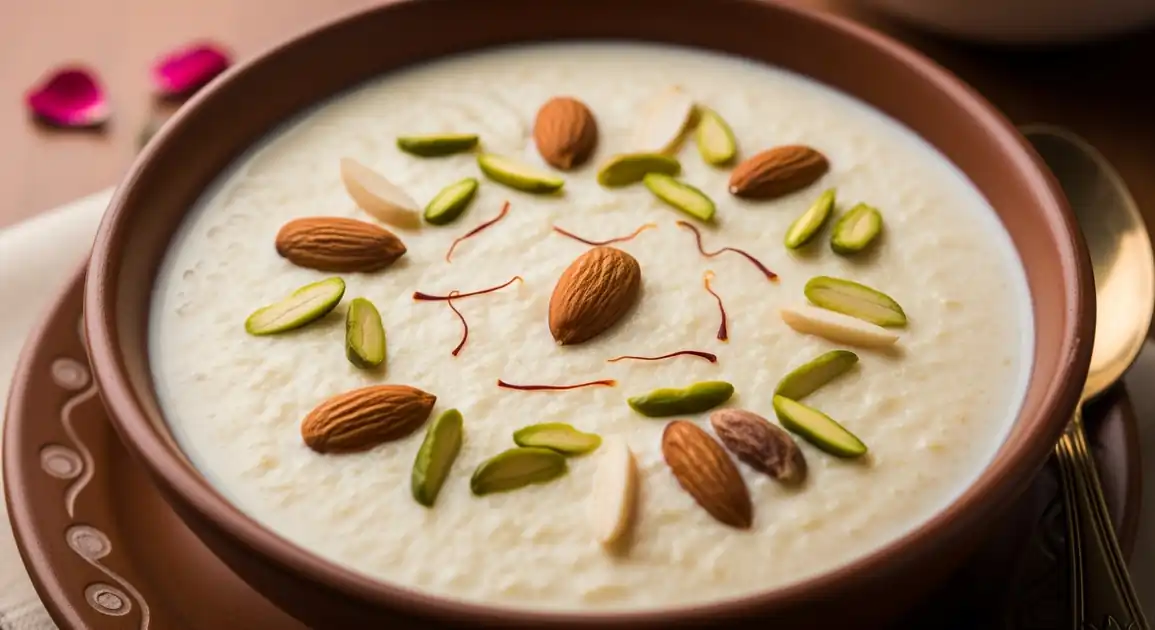Firni / Phirni (Rice Pudding)
फिरनी

Description
Firni/Phirni is a popular dessert across India, especially in North India and regions with significant Mughlai influence. It's readily available in sweet shops ('mithaiwalas'), North Indian/Mughlai restaurants, and is particularly prominent during festivals like Eid, Ramadan, and Diwali.
Dietary Information
Serving information
Serving style
Served chilled, typically in individual shallow earthenware bowls ('shikoras' or 'kulhads'). Eaten with a spoon.
Quick facts
Safety Tips
What to Look For
-
Purchase from clean, reputable sweet shops or restaurants with good hygiene standards.
Ensures safer handling practices and potentially fresher ingredients (especially milk).
-
Firni is properly chilled and stored in refrigeration.
Cold temperatures are essential to inhibit bacterial growth in dairy-based desserts.
-
Fresh appearance: creamy color, smooth surface, vibrant garnishes.
Visual cues can indicate freshness. Avoid Firni that looks dry, cracked, discolored, or has watery separation.
-
Pleasant milky, sweet, and aromatic smell.
Trust your sense of smell. Avoid anything smelling sour, stale, or 'off'.
-
Earthenware bowls ('shikoras') are clean and intact.
Ensures the serving vessel is hygienic.
What to avoid
-
Firni left unrefrigerated or displayed at room temperature for extended periods.
Major food safety risk due to potential bacterial growth in milk.
-
Shops with poor hygiene, flies, or unclean storage conditions.
Increases the risk of contamination.
-
Firni that looks dry, cracked, watery, discolored, or smells sour/stale.
Clear signs of spoilage or poor quality.
-
Garnishes (nuts) that look old, dull, or potentially moldy.
Stale nuts affect taste and quality.
Price information
Price range
Budget tips
- Prices are generally lower in local sweet shops compared to restaurants.
- Prices vary based on size and type (e.g., Kesar Firni often costs more).
- Buying directly from shops catering to specific communities (e.g., Muslim areas during Ramadan) can offer authentic taste at fair prices.
Value indicators
- Creamy, smooth texture without being watery.
- Served well-chilled in clean earthenware ('shikora').
- Balanced sweetness and distinct flavor (cardamom, saffron, rose).
- Fresh nut garnish.
Where to Find This Dish
Sweet Shops ('Mithaiwalas')
Found in markets and commercial areas across India, offering a variety of traditional sweets.
Local markets, Major sweet shop chains (e.g., Haldiram's, Bikanervala - though quality varies), Standalone traditional shops
Shop opening hours (typically 10 AM - 9 PM)
Mughlai/North Indian Restaurants
Offered as a standard dessert item.
Restaurants specializing in North Indian cuisine
Lunch, Dinner
Muslim Neighborhoods
Especially prominent during Ramadan and Eid in areas with significant Muslim populations.
Areas around major mosques, Specific food streets active during festivals
Evening (esp. during Ramadan), Festivals
Vendor Tips
- Look for shops that seem to have a high turnover of fresh sweets.
- Specify the type of Firni if variations (Kesar, Badam etc.) are available.
- Confirm ingredients if you have severe nut allergies, as garnishes are standard.
How to Order
Regional Variations
-
Kesar Firni
(केसर फिरनी)
Flavored and colored yellow with saffron strands, offering a distinct aroma and taste.
-
Badam Firni
(बादाम फिरनी)
Includes ground almonds mixed into the pudding or generously garnished with slivered almonds.
-
Pista Firni
(पिस्ता फिरनी)
Incorporates ground pistachios or is heavily garnished with slivered pistachios.
-
Rose Firni
(गुलाब फिरनी)
Flavored primarily with rosewater or sometimes garnished with edible rose petals.
-
Mango Firni (Seasonal)
(आम फिरनी)
Made during mango season, incorporating fresh mango pulp for flavor and color.
-
Shahi Firni
(शाही फिरनी)
A richer version ('royal'), potentially including more nuts, mawa (khoya), or richer flavorings.
Cultural context
History
Firni has its roots in Persian and Mughlai cuisine, which heavily influenced North Indian food. It became popular during the Mughal era and spread across the Indian subcontinent. Unlike Kheer (whole rice pudding), Firni's use of ground rice gives it a unique texture. Its association with festive occasions like Eid, Ramadan, and Diwali solidified its place as a celebratory dessert. Serving it in earthenware bowls is a traditional practice that helps cool the pudding and imparts a subtle earthy aroma.
Local significance
A beloved traditional dessert, strongly associated with festive celebrations and Mughlai culinary heritage. Represents comfort and sweetness in Indian culture.
Eating customs
- Enjoyed as a final course to a meal or as a standalone sweet treat.
- The earthenware bowl is part of the traditional experience.
- Savoring the cool, creamy texture and subtle aromas.